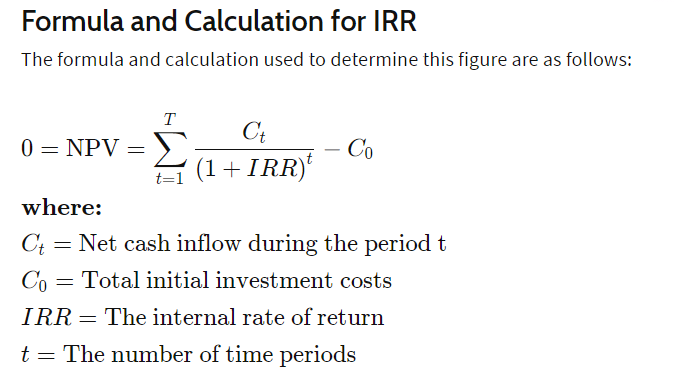What is XIRR in Mutual Funds?
5paisa Research Team
Last Updated: 02 Jan, 2025 12:18 PM IST

Content
- Introduction
- What is XIRR in Mutual Funds?
- XIRR in Mutual Funds-Fundamentals
- How can you use XIRR for investments?
- How do you calculate XIRR?
- How is XIRR a helpful metric in mutual fund investments?
- Different ways to determine XIRR
- XIRR in mutual funds
- Wrapping Up
Introduction
XIRR, or "internal rate of return", is a metric that shows the profitability of an investment. The internal rate of return is the discount rate that makes the series of cash flows net out to zero, which means it's the interest rate that makes the present value of all future cash flows equal to the initial investment.
The XIRR is used frequently in capital budgeting, and it's based on constant-amount cash flow streams. It relies on an accurate estimate of the future cash flow, so the internal rate of return is not appropriate for forecasting purposes. The internal rate of return provides information about profitability, not about timing.
More About Mutual Funds
- Advantages and Disadvantages of ELSS
- How to Plan Your ELSS Investments During the Year
- What is Passive ELSS?
- Does Mutual Fund Come Under 80C?
- Scheme Information Document (SID) in Mutual Funds
- What Are Tax-Exempt Mutual Funds & How Do They Work?
- Growth Mutual Funds Explained: Meaning & Types
- What Are Green Energy Mutual Funds?
- What are Fixed Income Mutual Funds?
- SIP vs SWP: Understanding the Key Differences & Benefits
- What is CAMS KRA?
- What is SIF (Specialised Investment Fund)?
- What Are Liquidity ETFs?
- Why Invest in ETFs Through SIPs?
- Difference Between ETFs and Stocks
- What is Gold ETF?
- Can We Pledge on Mutual Funds?
- Risks in Mutual Funds Investments
- Know How to Transfer Mutual Funds
- NPS vs ELSS
- XIRR vs CAGR: Understanding Investment Return Metrics
- SWP and Dividend Plan
- What is Solution Oriented Mutual Funds?
- Growth Vs Dividend Reinvestment Option
- Annual vs Trailing vs Rolling Returns
- How to Get Capital Gain Statement for Mutual Funds
- Mutual Funds Vs Real Estate
- Mutual Funds vs. Hedge Funds
- Target Maturity Funds
- How to Check Mutual Fund Status with Folio Number
- Oldest Mutual Funds In India
- History Of Mutual Funds In India
- How To Redeem ELSS Before 3 Years?
- Types of Index Funds
- Who Regulates Mutual Funds In India?
- Mutual Fund Vs. Share Market
- Absolute Return in Mutual Fund
- ELSS Lock in Period
- Treasury Bills Repurchase (TREPS)
- Target Date Fund
- Stock SIP vs Mutual Fund SIP
- ULIP vs ELSS
- Long Term Capital Gain Tax on Mutual Funds
- Smart Beta Funds
- Inverted Yield Curve
- Risk-Return Trade-Off
- Registrar and Transfer Agents (RTA)
- Mutual Funds Overlap
- Mutual Fund Redemption
- Mark to Market (MTM)
- Information Ratio
- Difference Between ETF and Index Fund
- Difference Between Mutual Fund and Index Fund
- Top 10 High Return Mutual Funds
- Passive Mutual Funds
- Passive Funds vs Active Funds
- Consolidated Account Statement
- Mutual Funds Minimum Investment
- What is Open Ended Mutual Fund?
- What is Closed End Mutual Fund?
- Real-Estate Mutual Funds
- How to Stop SIP?
- How to Invest in SIP
- What is a Blue Chip Fund?
- What is XIRR in Mutual Funds?
- What is a Hedge Fund?
- Tax Treatment of Long Term Capital Gains
- What is SIP?
- NAV in Mutual Funds
- Advantages of Mutual Funds
- Stocks vs Mutual Funds
- What is STP in Mutual Fund
- How Mutual Fund Works?
- What is Mutual Fund NAV?
- What are Mutual Funds?
- Mutual Fund Cut Off Time
- Mutual Fund the Best Investment Option for Conservative Investors
- Advantages and Disadvantages of Mutual Funds
- How to Choose Mutual Funds in India?
- How to Invest In Mutual Funds?
- How to Calculate NAV of Mutual Fund?
- What Is CAGR In Mutual Funds?
- AUM in Mutual Fund
- Total Expense Ratio
- What is XIRR in Mutual Funds?
- What is SWP in Mutual Fund
- How to Calculate Mutual Fund Return?
- Gold Mutual Funds
- Tax On Mutual Fund Investment
- The Top Benefits and Drawbacks of The Rupee Cost Averaging Approach
- How to Start a SIP Investment?
- What Is SIP & How does SIP Work?
- Best SIP Plans for Long Term: How and Where to Invest
- Best SIP Mutual Fund Plans
- ELSS Vs SIP
- List of Mutual Fund Managers in India
- What is NFO?
- Difference Between ETF and Mutual Fund
- ULIPs VS Mutual Funds
- Direct Vs. Regular Mutual Funds: What’s The Difference?
- ELSS vs Equity Mutual Fund
- NPS vs Mutual Fund
- Can NRIs Invest in Mutual Funds?
- Mutual Funds Categorisation In India
- Everything You Need to Know About Small-Cap Funds
- What is Public Provident Fund ?
- What is Large Cap Mutual Fund ?
- What is Index Fund ?
- What is IDCW in Mutual Fund ?
- What is Hybrid Fund?
- What is Gilt Fund ?
- What is ELSS Fund ?
- What is Debt Funds?
- What is an Asset Management Company - A Thorough Explanation
- What are Mid Cap Funds
- Liquid Funds - What are Liquid Funds?
- A Beginner's Guide to Investing in Fund of Funds Read More
Disclaimer: Investment in securities market are subject to market risks, read all the related documents carefully before investing. For detailed disclaimer please Click here.




